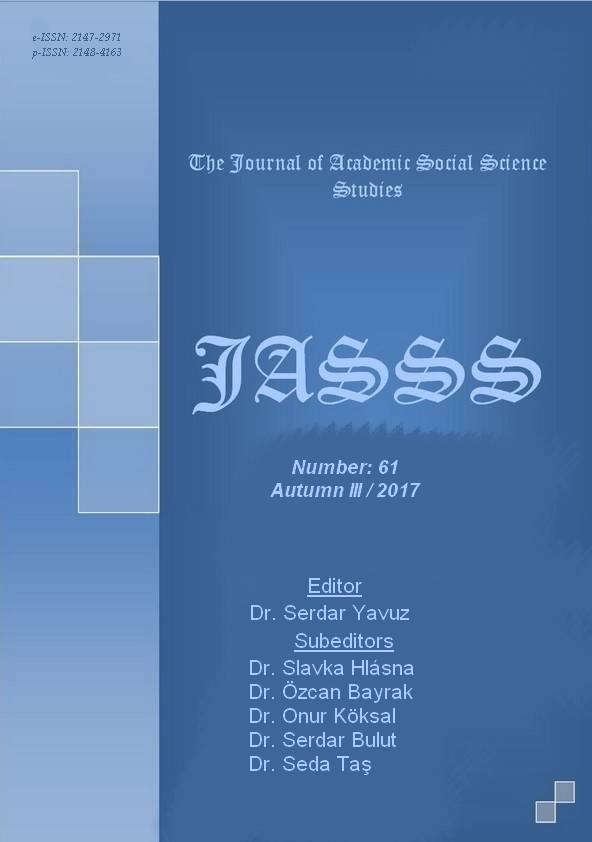NINIAN SMART’A GÖRE DÜNYA DİNLERİNİN BOYUTLARI: THE WORLD’S RELIGIONS ADLI ESER EKSENİNDE BİR İNCELEME
Author :
Abstract
Ninian Smart, eserlerinde fenomenolojik yaklaşımı hâkim kılarak, dini/dinleri/dindarı anlamada değer yargısız bir noktaya ulaşmayı hedefleyen bir din bilimcisidir. Bu doğrultuda onun kullandığı yöntemlerin başında yedi boyutlu din modeli gelir. Onun ikili tarzda isimlendirdiği bu model; pratik- ritüel, tecrübi- duygusal, hikayesel- mitolojik, doktrinel- felsefi, ahlaki- yasal, sosyal- organizasyonel ve materyal- sanatsal boyutlardan oluşur. Yedi boyutlu din modelindeki her bir boyut geniş bir alana sahip olmakla beraber diğer boyutlarla da ilişkilidir. O bütün dinleri bu model aracılığıyla incelemenin mümkün olduğunu ve bütün dinlerde bu boyutların mevcudiyetinin tespit edilebileceğini savunur. Ancak bütün dinlerin söz konusu yedi boyutun her birine sahip olduğundan hareketle, her dinde faklı boyutların daha fazla vurgulandığına dikkat çeker. Smart’ın bu model bağlamında en son ve en kapsamlı çalışmalarından biri olma özelliği taşıyan The World’s Religions adlı eseri ön plana çıkar. O bu eserde, yedi boyutlu din modeli bağlamında, geçmişten günümüze dünyada tezahür etmiş pek çok dini geleneğin bütüncül bir resmini, fenomenolojik tarzda ortaya koymayı amaçlar. Bu doğrultuda, özellikle büyük dünya dinleri olarak nitelendirdiği Hinduizm, Budizm, Yahudilik ve Hıristiyanlık dinleriyle ilgili önemli analizler ortaya koyar. Bu makalede, Smart’ın The World’s Religions adlı eseri bağlamında söz konusu dinlerle ilgili boyutsal analizlerinin genel özellikleri incelenmektedir. Bu şekilde Smart’ın yedi boyutlu din modelini tanıtarak, bu yöntemin kullanımına yönelik araştırmacılara/okurlara bir bakış açısı sunulması hedeflenmektedir.
Keywords
Abstract
Ninian Smart is a religious scientist who aims to reach a point where there is value-free judicial value in the sense of religion / religions / religious by making the phenomenological approach dominant in his works. In this contex, the seven-dimensional model of religion that he has used is at the beginning of his methods. This model that he named the “dual model” consists of dimensions practice-ritual, experience-emotional, narrative-mythic, doctrinal-philosophical, ethical-legal, social-institutional and material-artistic. Each dimension in the seven-dimensional model of religion has a large area and is associated with other dimensions. He argues that it is possible to examine all religions through this model and that the presence of these dimensions in all religions can be determined. As all religions, however, have each of these seven dimensions, he draws attention to the fact that more than one dimension is more emphasized. In the sense of this model, the work of The World’s Religions, which features Smart's latest and most comprehensive work comes to the fore. In this work, he seeks to reveal in a holistic, phenomenological manner of the many religious traditions that have manifested themselves in the world in the context of the seven-dimensional religion model. In this direction, he reveals important analyzes of the religions of Hinduism, Buddhism, Judaism and Christianity, which he describes as the great world religions. In this article, Smart's general characteristics of the dimensional analysis of religions in the context of “The World's Religions” are examined. By introducing Smart's seven-dimensional religion model, it is aimed to present a viewpoint to the researchers / readers about the usage of this method.
